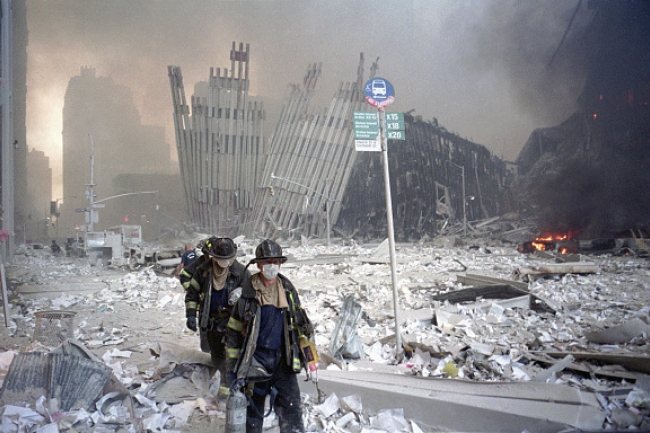by Eden Stiffman
This article originally appeared in The Chronicle of Philanthropy and has been reposted with their permission.
 After 9/11, many charities stopped talking to their donors and then waited too long to open up the dialogue again, says Laura MacDonald, vice chair of the Giving USA Foundation. Photo credit: NEVILLE ELDER/CORBIS/GETTY IMAGES
After 9/11, many charities stopped talking to their donors and then waited too long to open up the dialogue again, says Laura MacDonald, vice chair of the Giving USA Foundation. Photo credit: NEVILLE ELDER/CORBIS/GETTY IMAGES
As uncertainty about the coronavirus pandemic continued to rattle markets and our psyches, a group of America’s foremost experts on giving and fundraising happened to be gathered for a regular board meeting of Giving USA — and ended up shaping recommendations for how all nonprofits can respond. Their main advice: Don’t stop talking to big donors just because the world is being shaken. Past experience shows some donors never forgive the charities that don’t reach out in times of need.
Some 35 people who work in fundraising or consulting, technology, or other businesses that provide fundraising guidance or services to nonprofits shared their ideas with one another.
The Chronicle asked one of them, Laura MacDonald, vice chair of the Giving USA Foundation, which publishes the annual “Giving USA” report on fundraising trends, about what fundraisers can learn from past crises — like the 2001 terrorism attack, the Great Recession, the dot-com crash, and even the Bernie Madoff Ponzi scheme scandal. “Certainly we can learn from those, although this is different from any anything we’ve ever traversed before,” said MacDonald, who is also a principal at the Benefactor Group. “We’re just doing the best we can.”
Tell me what you saw fundraisers doing during those past crises. What worked well and what should fundraisers avoid doing now?
9/11 was such a shock to our whole system, to everyone nationally, that none of us knew what to do in the aftermath. We waited too long before we returned to dialogue with our donors. Many organizations stopped talking to their donors. They stopped asking for longer than they should have, and I think ultimately it hurt them. Or donors went to other causes that seemed more relevant.
If you can make a case for your relevance in this time, then be in communication with donors soon. Right now, it’s prudent for everybody to take a step back and observe what’s going on. Some people might want you to wait even longer, but as soon as there is any kind of clarity on the horizon, charities should be in communication with your donors. Even if you’re not asking, inform them about how you’re responding to the situation in your community and give them the opportunity to give if they wish to.
What did you see during the Great Recession?
When the equity markets dropped 40 percent — and knock on wood it won’t be quite that deep this time — charitable giving dropped 4 percent that year. Some giving behaviors changed. Some donors were unprepared to commit to multiyear pledges, understandably, but they were willing to make the first payment on what might eventually become a multiyear gift. Some donors turned their attention away from what seemed like noble but discretionary building programs and instead focused their giving on basic needs.
What about in the wake of the dot-com crash?
When the dot-com bubble burst, our client the World YWCA was in the midst of securing a million-dollar pledge, which the donor fulfilled with a technology stock. By the time the transfer got across the pond to Geneva, Switzerland [where the group had its headquarters], the million dollars had become $920,000. The stock was falling that rapidly. It was a donor of great capacity and so they simply brought it to his attention that the stock had failed to fulfill the million-dollar commitment, and did so in a very gracious and diplomatic manner. He immediately wrote a check for the difference. So people will be seeing that. And with this turbulent stock market, if anybody does make a gift of securities, which I think will be unusual in these times, just share the facts with your donors.
What about the Bernie Madoff embezzlement scandal?
When the Bernie Madoff crisis hit, a lot of Jewish philanthropists were affected by that. I can remember an interview with one donor during a feasibility study. This donor talked about the fact that she had two experiences when she was in her period of uncertainty. Some organizations called and said, ‘We understand that now is not the time for you to be making financial decisions about charitable giving, but we’re having our gala next week and it just wouldn’t be the same without you so we’d like you to come as our guest.”
Other organizations didn’t say anything to her. They didn’t contact her. They didn’t even acknowledge that she still existed. Her attitude was, “The organizations I didn’t hear from, I won’t be giving to in the future. That organization that invited me to their gala knowing my circumstances, I will continue to be a donor to them for the rest of my life.”
Right now, charities are canceling their galas and gatherings. How can they continue to engage donors?
Go with the most personal medium you can. If you think they’ve got the capacity for a video conference, then use Skype or FaceTime or Zoom. If that’s going to be tough on their end, pick up the phone and have a conversation. Listen to them and be a non-anxious presence. If you can’t reach them because they’re not at their office, and that’s the only contact information you’ve got, then send an email, but make it a personal email. So not “I hope all of you are faring well in this crisis,” but “I hope you are faring well in these difficult times.”
How else are your clients keeping in touch with their big donors, especially those that are older and especially vulnerable to the coronavirus?
They certainly want to be sensitive to the restrictions that are currently in place. Nobody wants to inadvertently expose someone else to the dangers of the virus. So they are using technology and finding out how [donors are] doing, and then sharing with the donor the plans for the institution. They want to check in and make sure that their key stakeholders are navigating this well. They’re not talking about soliciting new gifts at this time.
If the donor seems to be amenable, they’re exploring with them ways in which they may be helpful as the organization navigates its uncharted waters. In some instances, they may be pivoting from a discussion about a capital campaign or endowment gift, and if the donor seems receptive, talking about the contingency measures they have in place to remain resilient through this crisis.
Where appropriate, they may be pursuing conversations with donors about either securing new support to help navigate this crisis or, in some instances, possibly reallocating this year’s capital-campaign pledge payment to operating support. In some cases talking to donors who have narrowly restricted endowment funds and talking to them about possibly relaxing those restrictions for this extraordinary period of time and being able to use the draws instead for a specific programmatic purpose — maybe applying them to general operating support.
What is the long-term impact on giving we might see from this crisis?
We do need to be inventive in how we continue to engage various audiences. Anecdotally, we know that, for example, graduating classes from 1968 when there were all sorts of disruptions on college campuses across America, their giving tends to be lower than the classes before or after them. One of our colleagues shared an anecdote about an institution whose commencement was rained out 15 years ago, and giving from that class is 60 percent lower from the class before them and the class after them.
That class of 2020, that’s missing a commencement, do you invite them to come back next year or have a special commencement for them in the fall if things are clearer? How do we not just move on after this but acknowledge some of the things that people have missed?
Do you think this crisis could have an impact on the share of households who give to charity?
We need to revisit the way that we’re talking about this. While it might be 56 percent of households who give any one year, if we broaden our time horizon and look over a broader period of time, it’s actually a higher percentage. I also think we may see that Americans are expressing their generosity in any number of ways, which might or might not be counted in our formal philanthropic economy.
So whether it’s picking up groceries for your elderly neighbor or going to a GoFundMe page, activities like that generally don’t get counted in our formal philanthropic economy. But this may be an opportunity for us to begin to recognize them more fully because those are some of the ways that households of modest means do express their generosity at this time.
We’ll also see that the 53 percent of American households who live paycheck to paycheck are going to be strained to provide financial support. And the households at the very top end whose giving might be tied to their equity investments are also going to want to sit on the sidelines a bit while they see what this crazy stock market does.
But there’s a wide swath of households in the middle that are probably the households that used to itemize their charitable giving in their tax returns and now no longer will. And yet I think they may be the ones that they’ve got some savings stashed away, some liquidity, and are able to reach out and give during these difficult times. They may be the ones where we see a little bit of balance in their participation in charitable giving.
This transcript has been edited for brevity and clarity.



